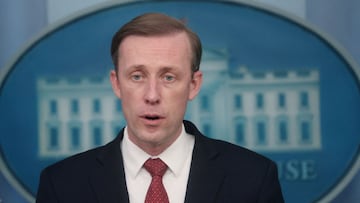What did Jake Sullivan say about the situation between Ukraine and Russia?
President Biden's national security advisor gave a White House press conference on Friday, confirming that US intelligence suggests that an invasion is imminent.


In recent weeks the conflict on the border between Ukraine and Russia has escalated rapidly as Russian President Vladimir Putin amasses a considerable military presence on the ground.
Those tensions appear to have reached new heights over the past 24 hours and reports suggest that Putin has told his military generals to prepare for invasion. In a White House news briefing on Friday US National Security Adviser Jake Sullivan warned that an attack could be imminent.
“As we’ve said before, we are in the window when an invasion could begin at any time, should Vladimir Putin decide to order it,” Sullivan told reporters.
“I will not comment on the details of our intelligence information, but I do want to be clear: It could begin during the Olympics, despite a lot of speculation that it would only happen after the Olympics.”
‘We are in the window when an invasion could begin at any time’ — National Security Adviser Jake Sullivan says the U.S. is prepared if Russia decides to invade Ukraine during the Winter Olympics pic.twitter.com/iXiPNiseRu
— NowThis (@nowthisnews) February 11, 2022
In response a Russian ministry statement published online on Friday insists that reports of an invasion are unfounded and blamed “a media campaign unprecedented in its scale and sophistication” for the allegations.
President Joe Biden will speak with Putin on Saturday to discuss the situation in Eastern Europe and attempt to deescalate matters.
Russian troops stationed on the Ukrainian border
For weeks Putin has maintained that the 100,000 troops located at various points encircling Ukraine are simply carrying out military exercises. However he has warned that Russia could take unspecified "military-technical" action unless the West meets some of his demands, which would require a pledge from NATO never to admit Ukraine and to withdraw forces from Eastern Europe.
Ukraine vs Russia military by the numbers: pic.twitter.com/fsZF4Tkdib
— ian bremmer (@ianbremmer) January 21, 2022
Last month a statement from the US State Department confirmed: “What concerns us is the total picture… It is the amassing of 100,000 troops along Ukraine’s borders combined with moving forces into Belarus over the weekend … these numbers are beyond, of course, what we would expect with regard to a normal exercise.”
The Guardian reported that Russian troops have travelled more than 4,000 miles to reach Ukraine’s border, doing so on the pretence of a naval drill.
In addition to that a significant amount of weaponry, including elite spetsnaz troops and Iskander short-range ballistic missiles, has been relocated from Russia’s eastern military district. From that range, analysts predict that Russia would be able to target the Ukrainian capital of Kyiv.
Hopes of a diplomatic solution now seem distant
Last month US Secretary of State Antony Blinken travelled to Geneva to meet with representatives from both sides in the hope of finding a diplomatic solution. He met with Russian Foreign Minister Sergey Lavrov and the two are thought to have discussed the deployment of troops on the Ukrainian border.
I spoke today with transatlantic leaders to discuss our concerns about Russia’s military build-up around Ukraine. We are united in our diplomatic efforts and deterrence measures and are ready to impose massive economic costs if Russia chooses further aggression. pic.twitter.com/AC9FrTS9qN
— President Biden (@POTUS) February 11, 2022
Related stories
However the 90-minute meeting did not result in any new agreement between the two nations. Speaking after his meeting with Lavrov, Blinken told reporters: “If Russia wants to begin to convince the world that it has no aggressive intent toward Ukraine, a very good place to start would be by deescalating by bringing back and removing these forces from Ukraine’s borders.”
Ukraine was the most populous nation, aside from Russia, to emerge from the collapse of the Soviet Union in 1991 and there are many cultural and historical similarities between the two sovereign nations. A Russian take-over of Ukraine has long been one of President Putin's greatest ambitions, according to reports.

